

 The South African
The South African
Contributor to numerous publications, public lectures, and heritage projects, Glenn has a special interest in historical research, especially the history of Namaqualand, the Anglo-Boer War and the SA Navy. In addition, he has a keen interest in genealogy, medal collecting and research. This research has been shared through public lectures, teaching in schools, especially in Namaqualand, and via publication of articles and books as well as film ...
Although employed by the University of Cape Town, he is also an active member of the South African Naval Reserve. Since 2005, he has fulfilled a media and liaison role, including assisting the South African Sea Cadets.
In 2007, he was awarded the iPhrothiya yeBhronzi Medal for Leadership, Meritorious Service and Devotion to Duty.
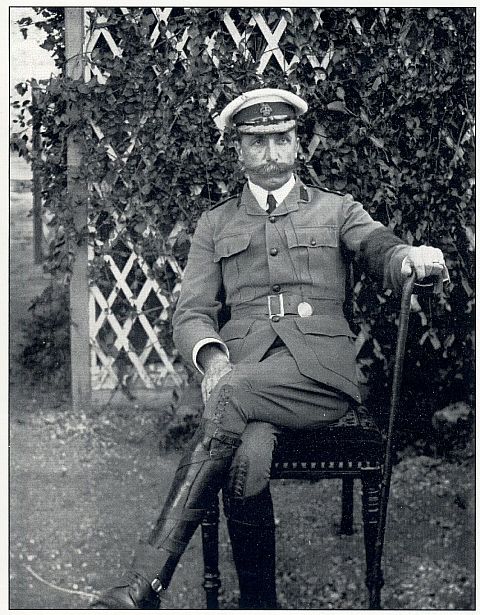
Introduction
Privates William Armstrong and William Douglas, both soldiers in the Duke of Edinburgh's Own Volunteer Rifles (DEOVR) with a combined service of but five months, lie interred in the wastelands of Namaqualand. These two 'Bills' attested in the DEOVR a month apart and died within a day of each other at separate localities. Both were buried with comrades in arms from other units.
Pte William Armstrong, No 3307, was born in 1861/2. He had been a seaman before attesting in the DEOVR on 24 March 1902 and had previously seen service with the Cape Garrison Artillery. He died on 28 April 1902 of wounds sustained during a skirmish at Steinkopf and is buried at Klipfontein along with three other casualties of the Anglo-Boer War, a corporal and two privates of the Imperial Yeomanry.
Pte William Douglas, No 2841, a teacher from Cape Town, was born in 1865/6 and attested on 26 February 1902. He succumbed to dysentery on 27 April 1902 at Port Nolloth and is buried in the town's historic cemetery along with a sergeant of the Cape Town Highlanders and two lance corporals of the Middlesex Regiment.
Background
After the fall of Pretoria on 5 June 1900, misread by the British politicians and the army as the end of the Anglo-Boer War, the war entered a guerilla phase. General Smuts along with several hundred Boers invaded the Cape Colony and made their way in the direction of Cape Town before heading north to the copper mining region of Namaqualand. Boer Commandos fought various skirmishes en route with a major engagement near van Rhynsdorp in which General Ben Bouwer was wounded.
In 1901 the High Commissioner of South Africa, Sir Alfred Milner, summoned Lt Col WAD Shelton, 3rd Royal West Surrey Regiment, and gave him his orders to secure the rich copper mines of Namaqualand, the railway line linking the mines with the coast, and the port of Port Nolloth.
Lt Col Shelton, with the support of a limited number of regular troops and local men recruited and trained by the copper companies, built defences in the towns, along the railway line and at Port Nolloth. The Namaqualand Town Guard Battalion was an amalgamation of various local Town Guards, while the Namaqualand Border Scouts were a mounted force with a dismounted one, which primarily served along the railway line.
Shelton's defence plan included a stronghold at O'okiep, the major mining town, defences at the smaller surrounding towns and mobile patrols tasked with intelligence gathering rather than engaging the enemy.
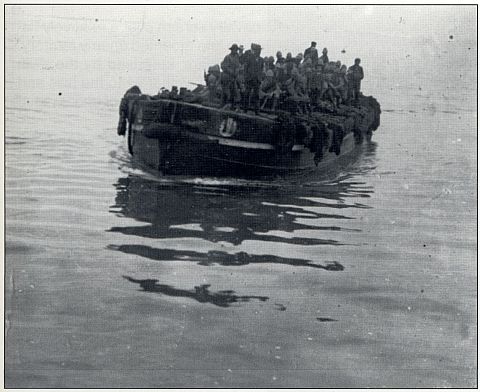
The Boer forces had split up in order to survive off the land and skirmishes were fought at the following localities en route: Near Garies a large contingent of the Namaqualand Field Force under Capt Montague was cut off from their HQ at O'okiep; at the Methodist Mission Station at Leliefontein Gen Maritz decimated the local militia after previously being run out of town; and, at Groote Kau, Gen Bower ambushed a patrol under Lt William Mcintyre who were returning from the Bushmanland.
The Boer Commandos regrouped south of Springbok and on 1 April 1902 attacked the town commanded by Lt Nugent Dorrington. The town's defence consisted of blockhouses with unconnected barbed wire entanglements and men armed with an assortment of rifles. Lt Dorrington's surrendered his own blockhouse when dynamite was placed under the beams. The defenders of the blockhouse in the town centre capitulated after an intense fire fight in which several were wounded. Two men, Ronald James Stewart and Henri van Coevoorden, were shot by Denys Reitz during a siege of the last blockhouse. The defenders were captured when they went in search of water after an engagement lasting seventeen hours.
While Lt Col Shelton was withdrawing troops, supplies and the civilian population to his HQ at O'okiep the Boer Commandos focused their attention on Concordia, a small copper mining town to the north-east. The Town Guard here had disobeyed instructions from Lt Col Shelton to relocate to O'okiep, preferring to defend their own town and the assets of the Namaqua Copper Company. They, however, surrendered without a single shot being fired to Gen Smuts who gave them an undertaking that the mine would not be damaged. Company supplies of explosives, rifles and ammunition were captured and subsequently used against Lt Col Shelton.
The small mining community of Nababeep, located west of O'okiep, was successfully evacuated before the Boers could stage an attack.
The siege of O'okiep commenced after Lt Col Shelton's troops and the civilian population, with most of the supplies, were holed up in the town. Lt Col Shelton had managed to send word of the siege to Port Nolloth via telegraph before the lines were cut and updated the officer commanding via various communiques smuggled out of O'okiep.
Relief force assembled
Upon receipt in Cape Town of the news of the siege, a relief force, mainly comprising Col Caldwell's Column then encamped at Matjesfontein, was constituted. This force comprised 'D' Squadron 5th Lancers, 116th and 118th Imperial Yeomanry, Cape Police, two guns of the 44th Battery Royal Field Artillery, as well as a contingent of DEOVR. Five companies of the 4th East Surrey Regiment, who had just arrived in Cape Town, were added to boost the relief force.
Col Harry Cooper, CMG, ADC, was given command of the relief force. The SS Nautilus with an officer, eight clerks, 50 DEOVR and supplies on board, sailed for Port Nolloth on 9 April 1902. This was followed a day later by the 13 000 ton SS Mapelmore with the majority of the relief force on board. The remainder of the personnel embarked on two boats, the SS Orient and the SS Sicilian on 11 April 1902. The balance of the equipment, horse and mules were transported on a second trip of the SS Mapelmore.
Relief force landed
The SS Nautilus arrived off Port Nolloth on 12 April and encountered HMS Forte and HMS Baracouta in the bay. Since it had been reported that the Boers were within sight of the town, a force of sailors, to reinforce the Town Guard, had been landed during the previous night. HMS Forte had also landed a Nordenfelt gun and a contingent of sailors to protect the town's only water supply on the railway line five miles (8 km) inland.
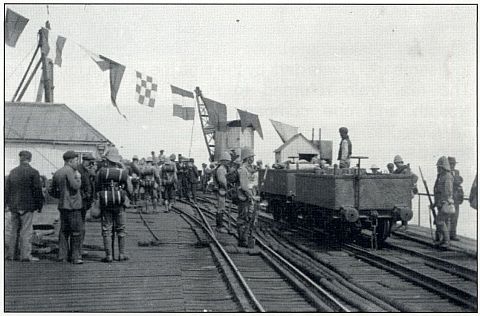
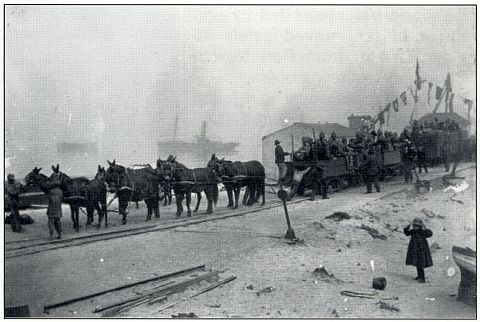
All troops were landed in heavy swells using the ships' boats, local tugs and lighters of the Cape Copper Company. As immersion seemed probable, soldiers were ordered to take off their bandoliers. Remarkably, only one rifle was lost during the landing with the last two companies landing after nightfall. It was the first time since Alma during the Crimean War (1S54) that British troops had been landed in ships' boats.
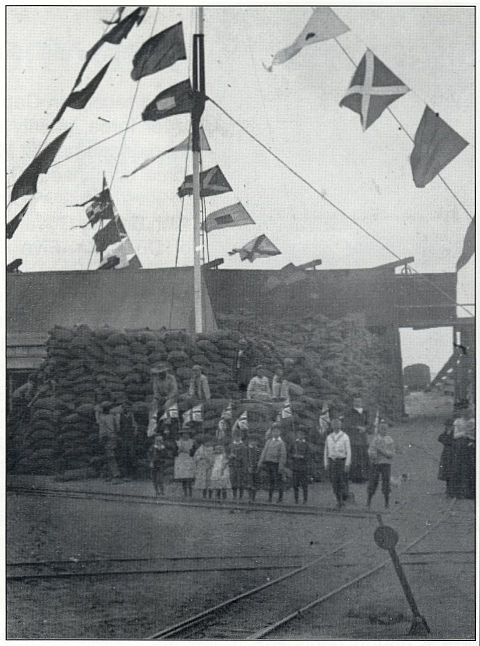
Two companies of the East Surreys deposited their kitbags in a store before entraining and were transported without rations in mineral trucks to Julies Hoogte, several miles from Port Nolloth, after dark. The water supply at this locality was considered vulnerable to attack. The blockhouse nearby was manned by members of the 2nd Namaqualand Border Scouts under Capt MacDonald.
At 04h30 the following morning, after standing to arms, a company of the DEOVR with some plate layers arrived by train to repair a 150 yard (137 metre) section of line that had been destroyed by the Boers. Col Sullivan, Officer Commanding East Surreys, ordered this train to proceed, stopping to repair minor breaks as they progressed, while another train followed slowly with his troops.
A culvert had been destroyed at Mile 42 and repair was adjudged to take some time. Col Sullivan ordered his troops to disembark. It was dark by the time the column formed up.
The rear train returned to Port Nolloth and one company was instructed to guard the remaining train, baggage and platelayers. The reduced column of some 300 men, with the DEOVR acting as advance guard, marched off to Anenous.
Anenous occupied
At Anenous the sandy desert abutted against the scarp, which was clearly visible in the moonlight. The column, comprised entirely of Militia and Volunteers led by one regular officer, arrived safely 45 miles (72 km) from Port Nolloth without any exchange of fire.
Cautious critics would have found fault with this advance had it failed and blamed the commander for his rashness. Had the Boers, who were observing from the hills, attacked in force they might have been successful as they held the high ground and faced raw recruits new to the terrain. The success of this advance was unique in that it had been made by infantry without any cavalry screen over a relatively flat plain into mounted enemy territory. The Boers, surprised by the swift advance, withdrew to the hills and left 50 miles (80 km) of undamaged railway line.
Anenous had been defended by Lt Nuffie Moffatt, 2nd Namaqualand Border Scouts and the Railway Traffic Manager, who had 50 odd troops defending three blockhouses. They had been called upon to surrender, an offer which was refused, but had not been attacked. Anenous was regarded as a strategic base for further advance into the escarpment. The column secured the position and awaited the arrival of the 5th Lancers and Yeomanry in a few days, while the Boers watched and waited from the high ground.
Col Cooper, along with the remainder of the East Surreys, arrived the following morning, 14 April 1902, the line then having been repaired to Anenous. One company with a Maxim was ordered to occupy a hill half a mile (8OO metres) beyond Anenous, which strategically guarded the village from the east and south, and another company was sent three miles (4,8 km) further along the line to guard the viaducts. The Boers had made many attempts to destroy the viaducts, but the 2nd Namaqualand Border Scouts had successfully defended these wooden bridges until relief arrived. The two companies built sangars and rough blockhouses and remained in position on the two hills until 30 April 1902.
The DEOVR was posted to a hill south-east of the viaducts and sections and half-companies of East Surreys and Namaqualand Border Scouts were picketed on other hills in the vicinity.
Meanwhile the Boer force was on the top of the escarpment at Klipfontein, eight miles (12,8 km) east of Anenous. During the next few days much blasting was heard as water tanks and culverts up the line were destroyed in preparation for a Boer retreat to Steinkopf, a strong position four miles (6,4 km) south of Klipfontein. Boer patrols in the area constantly monitored the relief force.
On 14 April 1902 records reveal that Privates J McLoone, G F Fletcher and W Green were wounded at Klipfontein.
'A' Squadron, 5th Lancers, duly arrived at Anenous by train on 16 April 1902, followed by the 118th Imperial Yeomanry, along with Lieutenant Ironside, Royal Field Artillery and two 15-pounder guns. Forty Cape Mounted Police arrived a little later to add mounted support to the column.
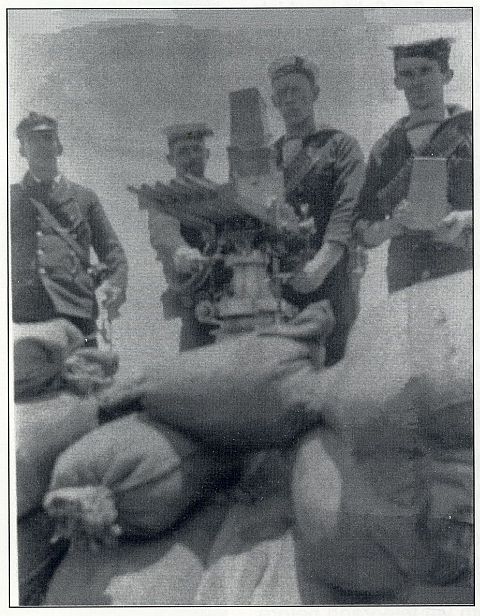
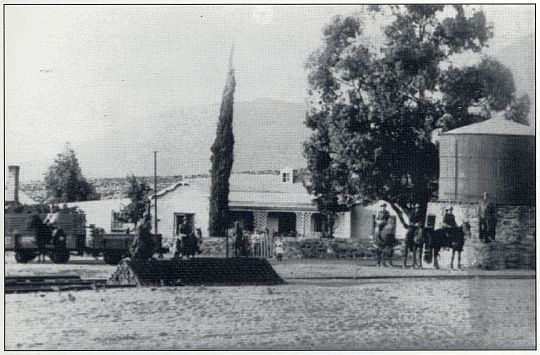
Klipfontein secured
Five days later, on 21 April 1902, Klipfontein was secured, the little place a scene of destruction. The huge water tank had been blown up and the interiors of the houses damaged. Mounted patrols encountered detached parties of Boers each day, but the main body of men was at Steinkopf. This position was so well masked by hills and natural defences that it was impossible to make the Boers disclose their strength and all attempts at getting on their flanks were frustrated.
On 26 April 1902 Gen Smuts, accompanied by Tottie Krige and Denys Reitz, came through the lines under a white flag of truce en route to the peace conference at Vereeniging. That afternoon Lt Col Caldwell made a reconnaissance towards Boer positions with all the available mounted men. His force proved too weak to attack the enemy position after Lt Mather, Imperial Yeomanry, and three men were wounded.
On the day thereafter, 27 April 1902, Private William Douglas died of dysentery and was buried in the Port Nolloth cemetery where he shares a headstone with Sergeant Ernest Honore of the Cape Town Highlanders, and Lance Corporal J Clarke of the Middlesex Regiment.
Action at Steinkopf
On 28 April 1902, in another reconnaissance under Col Cooper, two companies of the East Surreys managed to advance to within 400 yards (365 metres) of the Boer positions at Steinkopf. A company of DEOVR had occupied a position from the koppies above Steinkopf. In this sortie the relief force lost four killed and three wounded. Lt Ironside's guns, which were brought into action, contributed to most of the Boer casualties. It was in this action that Pte William Armstrong of the DEOVR was dangerously wounded. He subsequently died of his wounds and is buried in the Klipfontein cemetery along with Corporal McLaughlin and Private R E Plim of the 116th Imperial Yeomanry, and Private J B Parr of the Royal Artillery.
The next day, 29 April 1902, saw the arrival of two companies of the 2nd Battalion Royal Fusiliers under Capt Wolseley. These were the advance companies of the battalion and the remainder followed several days later.
Reinforced by these two companies of well-seasoned regulars Col Cooper decided to attack. The two companies of the 4th East Surreys who had been left behind in defence of Anenous and the viaducts were ordered to join the main body at Klipfontein on 30 April 1902. They were relieved by a company of the 3rd East Surreys who had been sent from Cape Town.
During that evening news had been received that many of the Boers had retired from their positions and were moving southwards to O'okiep. At dawn the following morning the relief column, consisting of all the mounted troops, the two companies of Fusiliers, three companies of East Surreys and the DEOVR, attacked the position at Steinkopf. During this attack pte A Pinder of the DEOVR was slightly wounded.
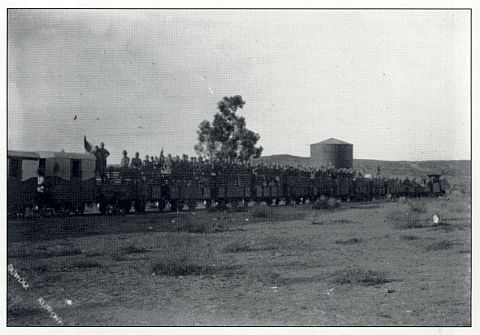
The intention was to stage a strong frontal attack on the centre of the defence position with the infantry while their advance was covered by the two 15-pounders, and for the cavalry to round the flanks and threaten the enemy's line of retreat. The line of infantry was extended over a front of two miles (3,2 km), searching every hill and koppie. However, within a mile of the expected defensive position of the Boers, information was received that they had already withdrawn. The column was ordered to march into Steinkopf and bivouacked in and around the village that night.
That evening a heliograph message to Col Cooper conveyed the good news that the garrison at O'okiep was fit and well and that the Boers intended to raise the siege.
O'okiep relieved
Lt Col Caldwell was dispatched with a flying column on 3 May 1902 and entered O'okiep on 4 May 1902 to lift the siege. The garrison, which had been besieged for a month and repelled all efforts to take the town, welcomed the relieving force. A thanksgiving parade was held to celebrate the relief of O'okiep.
Col Cooper took over the command from Lt Col Shelton and sent the cavalry to patrol the south, while calling up the Royal Fusiliers who had, in the meanwhile, arrived at Port Nolloth to reinforce the garrison. The platelayers had repaired the railway line and supplies were railed into the town from the coast.
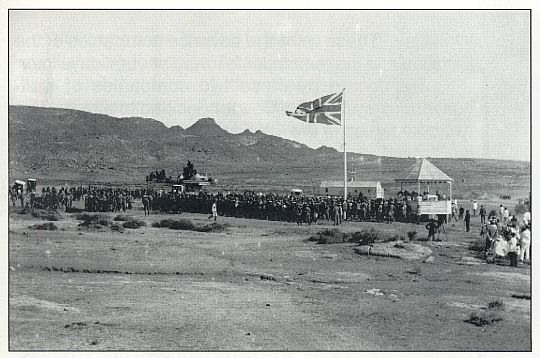
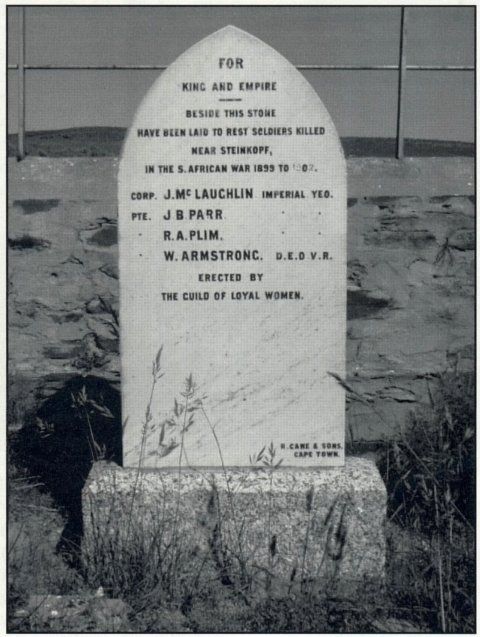
At the time of the signing of the Peace Accord at Vereeniging on 31 May 1902, all the companies had arrived at O'okiep. The local citizens entertained the relieving force after peace had been declared and football and cricket matches were staged. A field force canteen was opened and supplied all necessities for the men.
On 5 June 1902 peace celebrations took the form of a review of all the troops. The majority of the troops left the town in June; the cavalry trekking south to Cape Town and the infantry by train to Port Nolloth where they embarked on the Harlech Castle for Cape Town.
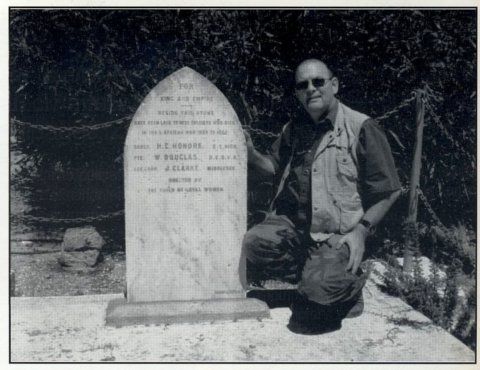
Conclusion
Two soldiers of the DEOVR, both named William, Privates Armstrong and Douglas, were interred in marked graves in Namaqualand to remind future generations that the DEOVR had contributed blood in the relief of O'okiep during the closing stages of the Anglo-Boer War. Sadly, they lost their lives within one and two days respectively, after Gen Smuts had already been summoned to travel to the Vereeniging Peace Conference on British transport. The officers and men of the DEOVR had served the relief column well and done their regiment proud. Their actions had resulted in the local population being free to return to their homes and farms while mining in the Copper District resumed.
BIBLIOGRAPHY
Anon, 'The Relief of O'okiep' in Royal Engineers Journal, 1903.
Burke, P, The Siege of O'okiep: Guerilla Campaign in the Anglo-Boer War (War Museum of the Boer Republics, imprint, 1995).
Kiernan, B, O'okiep: The Relief and Defence of O'okiep (Brian L Kiernan, 1995).
Le Riche, P J, Memoirs of General Ben Bouwer (Human Sciences Research Council, 1980).
Maritz, M, My lewe en my strewe (Generaal Manie Maritz,1939).
McKenzie, A, The Dukes: A History of the Duke of Edinburgh's Own Rifles 1855-1956 (Regimental Council of the DUKES, 1956).
Nasson, B, Abraham Esau's War: A Black South African War in the Cape, 1899-1902 (Cambridge University Press, 1991).
Orpen, N, The Dukes: A History of the Cape Town Rifles (Cape Town Rifles Dukes Regimental Council, 1984).
Reitz, D, Commando (Faber & Faber, 1929).
Smalberger, J M, A history of copper mining in Namaqualand (C Struik, 1975).
Thomas, D, The men who would not march (Print Matters, 2011).
van Zeil, A-G, 'The Defence of O'okiep' (unpublished research).
van Zeil, A-G, 'Okiep - an example of the urban lifecycle of a mining town' (unpublished Honours thesis, University of Cape Town, 1988):
Return to Journal Index OR Society's Home page
South African Military History Society / scribe@samilitaryhistory.org